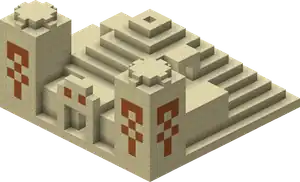Desert Pyramid/Structure
This page documents the layer-by-layer composition of a given generated structure, terrain feature, or feature.

Materials
| Block | Amount |
|---|---|
| 2 | |
| 4 | |
| 62 | |
| 238 | |
| 66 | |
| 101-103[note 1][note 2] | |
| 2885+[note 2][note 3] | |
| 2 | |
| 17 | |
| 1 | |
| 6-8[note 1][note 2] | |
| 9 |
- Notes
- ↑ a b 83 blocks buried in the cellar room are generated as sand initially. 5 to 7 of these are replaced with suspicious sand in random positions.
- ↑ a b c Of the 25 blocks which make up the cellar room's collapsed roof, 33% is sandstone, while the rest is sand. One of these blocks is replaced with suspicious sand. On average, the cellar roof consists of 8 sandstone, 16 sand, and 1 suspicious sand, which this tally reflects.
- ↑ Additional layers of sandstone may generate from the base of the pyramid to the ground.
Blueprint
| Layer | Block | Facing |
|---|---|---|
| -11 | Pressure Plate | |
| 10 | Middle Sandstone |
NOTE: Red, green, and blue wool do not actually generate. In this blueprint, they represent:
- Red wool: Blocks buried in cellar room, which consists of sand and suspicious sand. Consult #Materials for generation rules.
- Green wool: One sand block and one sandstone block. They are mutually exclusive (i.e. if sand generates in one position, then sandstone will generate in the other).
- Blue wool: Blocks which make up the collapsed roof of the cellar room. Consult #Materials for generation rules.